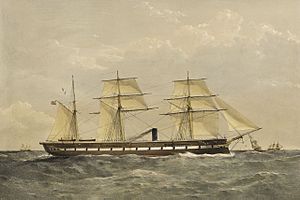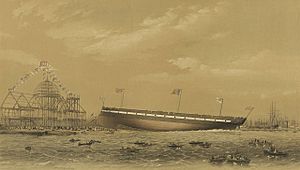HMS Resistance (1861) facts for kids

Resistance in 1861, by Thomas Goldsworthy Dutton
|
|
Quick facts for kids History |
|
|---|---|
| Ordered | 14 December 1859 |
| Builder | Westwood, Baillie, Poplar, London |
| Laid down | 21 December 1859 |
| Launched | 11 April 1861 |
| Completed | 5 October 1862 |
| Commissioned | July 1862 |
| Decommissioned | 1880 |
| Nickname(s) | Old Rammo |
| Fate | Sold for scrap, 11 November 1898 |
| General characteristics | |
| Class and type | Defence-class armoured frigate |
| Displacement | 6,070 long tons (6,170 t) |
| Length | 280 ft (85.3 m) |
| Beam | 54 ft 2 in (16.5 m) |
| Draught | 26 ft 2 in (8 m) |
| Installed power | |
| Propulsion | 1 shaft, 1 trunk steam engine |
| Sail plan | Ship rig |
| Speed | 11 knots (20 km/h; 13 mph) |
| Range | 1,670 nmi (3,090 km; 1,920 mi) at 10 knots (19 km/h; 12 mph) |
| Complement | 460 |
| Armament |
|
| Armour |
|
HMS Resistance was a powerful warship built for the Royal Navy in the 1860s. She was one of two ships in the Defence-class ironclad class. These ships were special because they had thick iron armor, making them "ironclads."
Resistance was the first big warship in the Royal Navy to have a naval ram. This ram was like a giant plough at the front of the ship. It was designed to smash into enemy ships during battle. Because of this, she earned the nickname Old Rammo.
After she was built, Resistance first joined the Channel Fleet. Later, in 1864, she moved to the Mediterranean Fleet. She was the very first ironclad ship to serve in that fleet. Over the years, her weapons were updated. She also served as a guardship and returned to the Channel Fleet before being taken out of service in 1880. From 1885, Resistance was used for important tests on guns and torpedoes. She was sold for scrap in 1898.
Contents
Design and Features of HMS Resistance
The Defence-class ironclads, like Resistance, were designed to be smaller and cheaper than the bigger Warrior-class ships. This meant they couldn't have the same powerful engines. They were also a bit slower and carried fewer guns.
HMS Resistance was about 280 feet (85.3 m) long. She was 54 feet 2 inches (16.5 m) wide and sat 26 feet 2 inches (8 m) deep in the water. The ship weighed about 6,070 long tons (6,170 t). Her special ram was shaped like a plough. Inside, the ship's hull was divided into 92 watertight sections. This helped prevent too much flooding if the ship was damaged.
How Resistance Moved
The Defence-class ships had one steam engine with two cylinders. This engine powered a single 21-foot (6.4 m) propeller. Four large boilers created steam for the engine. This engine could produce about 2,329 indicated horsepower (1,737 kW) of power. During tests, Resistance could reach a top speed of about 11.4 knots (21.1 km/h; 13.1 mph). She could carry 450 long tons (460 t) of coal. This was enough to travel 1,670 nautical miles (3,090 km; 1,920 mi) (about 3,093 kilometers) at a speed of 10 knots (19 km/h; 12 mph).
The ironclad also had sails, like a traditional sailing ship. She was rigged like a full-rigged ship. Her lower masts and bowsprit (the pole sticking out from the front) were made of iron. This made them strong enough to handle the force of ramming another ship. Resistance could sail at about 10.5 knots (19.4 km/h; 12.1 mph) using only her sails. Her funnel could be lowered to reduce wind resistance when sailing. The ship's propeller could also be lifted out of the water. This helped reduce drag when the ship was just sailing.
Weapons of Resistance
When first built, Resistance was meant to have 18 large 68-pounder guns. These were smoothbore guns, meaning the inside of the barrel was smooth. She was also supposed to have four smaller 40-pounder guns.
However, her actual weapons changed during construction. She ended up with:
- Six 110-pounder breech-loading guns. These were new types of guns.
- Ten 68-pounder smoothbore guns.
- Two 32-pounder smoothbore guns.
Tests showed that the new 110-pounder guns were not as good at breaking armor as the older 68-pounder guns. Also, these new guns sometimes had problems with their breeches (the back part where the shell is loaded) exploding. Because of these issues, the navy started to remove the 110-pounder guns from service.
The 68-pounder gun fired a solid shot weighing about 68 pounds (30.8 kg). It could shoot about 3,200 yards (2,900 m) (2,926 meters). The 110-pounder gun fired a shell weighing around 107–110 pounds (48.5–49.9 kg). It had a longer range of about 4,000 yards (3,700 m) (3,658 meters).
In 1867–1868, Resistance was updated with new weapons. She received:
- Fourteen 7-inch rifled muzzle-loading guns.
- Two 8-inch rifled muzzle-loading guns.
These new guns were heavier and more powerful. The 8-inch gun fired a 175 pounds (79.4 kg) shell and could break through about 9.6 inches (244 mm) of iron armor. The 7-inch gun fired a 112 pounds (50.8 kg) shell and could penetrate about 7.7-inch (196 mm) of armor.
Ship Armor
The Defence-class ships had a belt of wrought iron armor. This armor was 4.5 inches (114 mm) thick. It covered the middle part of the ship for about 140 feet (42.7 m). The armor stretched from the upper deck down to 6 feet (1.8 m) below the waterline.
Thick 4.5 inches (114 mm) iron walls, called bulkheads, protected the guns on the main deck. Behind the armor was 18 inches (460 mm) of strong teak wood. The front and back ends of the ship had no armor. This meant the steering parts were easy to hit. However, these areas were divided into many watertight sections to help prevent sinking if they were damaged.
Building and Service of Resistance
Resistance was ordered on 14 December 1859. Her construction began a week later at the Westwood, Baillie shipyard in Cubitt Town, London. She was launched into the water on 11 April 1861. The ship was officially ready for service in July 1862 and finished on 5 October. Her total cost was about £258,120.
After being completed, Resistance served in the Channel Fleet until 1864. Then, she was moved to the Mediterranean Fleet. She was the first British ironclad to join that fleet. In 1867, the ship returned to Portsmouth for updates and to get her new weapons.
In 1869, Resistance became a guardship in the River Mersey. She stayed there until 1873, when she rejoined the Channel Fleet. In 1877, she went back to being the Mersey guardship. Finally, in 1880, she was taken out of service at Devonport.
From 1885, Resistance was used for important tests. She became a target to see how well armor could withstand torpedoes and gunfire. On 3 February 1888, she sank in Portchester Creek after a test with a Whitehead torpedo.
The End of Resistance
Resistance was sold for scrap to a company in Glasgow on 11 November 1898. On 4 February 1899, she was being towed from Spithead to the Mersey to be broken up. During a storm in the Irish Sea, her steering system failed. Water also started to leak into the front parts of the ship.
Because of the leaks and steering problems, the tugboats towing her looked for a safe place. They brought her to anchor near Holyhead Breakwater. The next morning, it was clear the ship was taking on more water and would sink. To prevent her from being a danger to other ships, she was towed further into the harbor and put ashore in Penrhos Bay.
After rescue efforts, Resistance was refloated on 17 February. She was then towed the rest of the way to the Mersey. On 13 March, she was beached near Garston. There, she was finally broken up by a company called Monks, Hall & Co.



